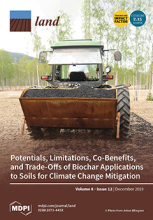Land Library Search
Through our robust search engine, you can search for any item of the over 73,000 highly curated resources in the Land Library.
If you would like to find an overview of what is possible, feel free to peruse the Search Guide.
/ library resources
Showing items 1 through 9 of 56.The planting of sand-binding vegetation in the Qinghai Lake watershed at the northeastern edge of the Qinghai–Tibet Plateau began in 1980. For this paper, we took the desert on the eastern shore of Qinghai Lake as the study area.
The renewal of historic gardens, landscapes, and sites has grown to be a current issue in Central and Eastern Europe.
The implications of change on local processes have attracted significant research interest in recent times. In urban settings, green spaces and forests have attracted much attention.
Protected areas offer diverse ecosystem services, including cultural services related to recreation, which contribute manifold to human wellbeing and the economy. However, multiple pressures from other human activities often compromise ecosystem service delivery from protected areas.
In recent years, the sugar industry in Malawi has been criticized for its connections to land-grabbing. The general trend in the current literature has been the attempt to identify the main actors and factors that were instrumental in the displacement of local communities.
Turbulent periods of transition from socialism to neoliberal capitalism, which have affected the relationships between holders of power and governing structures in Serbia, have left a lasting impact on the urban spaces of Belgrade’s cityscape.
Te Tiriti o Waitangi, signed between Māori rangatira (chiefs) and the British Crown in 1840 guaranteed to Māori the ‘full, exclusive and undisturbed possession of their lands’.
The use of land consolidation on customary lands has been limited, though land fragmentation persists. Land fragmentation on customary lands has two main causes—the nature of the customary land tenure system, and the somewhat linked agricultural system.
In recent years, as a way to achieve higher agricultural output while reducing the negative impact of agricultural production on the environment, agricultural sustainable intensification has attracted worldwide attention.


